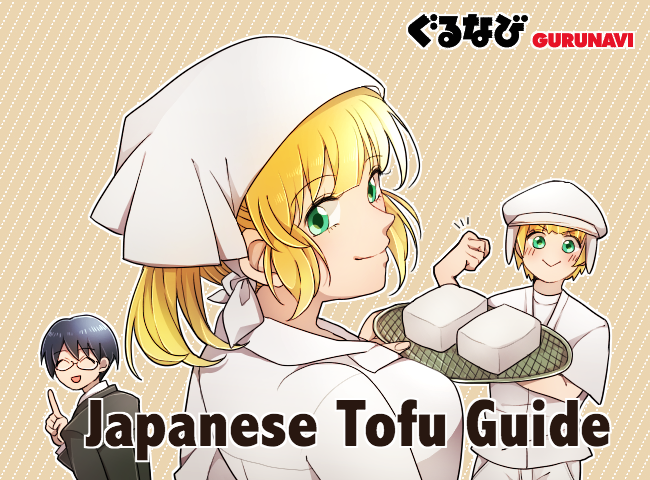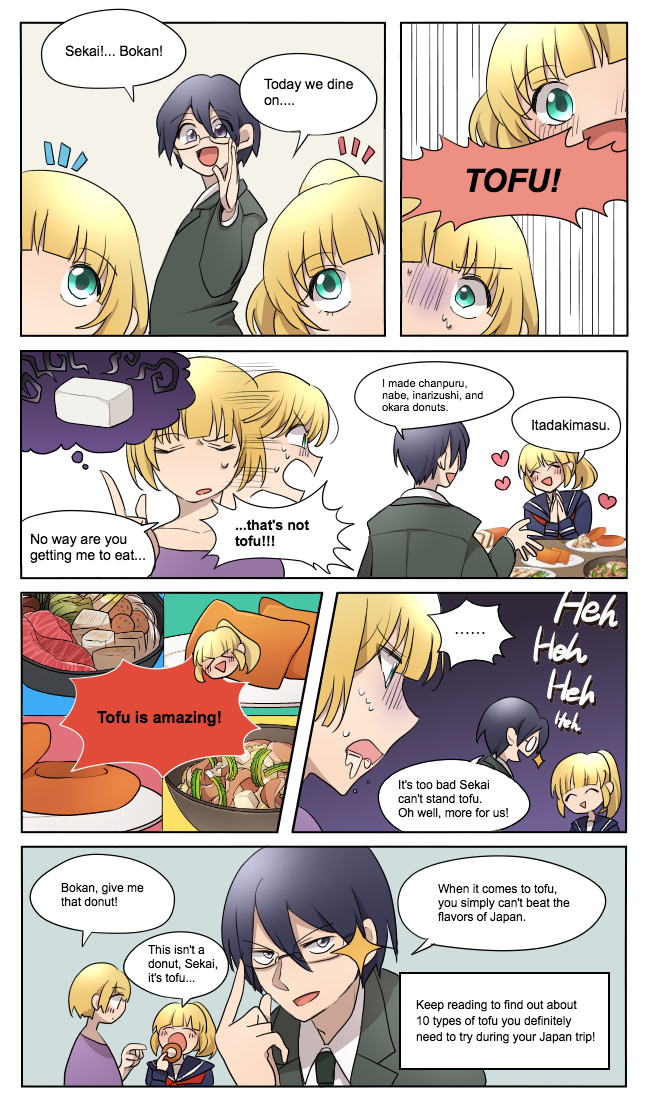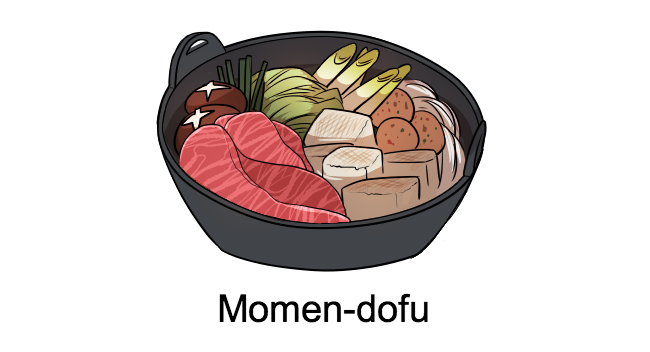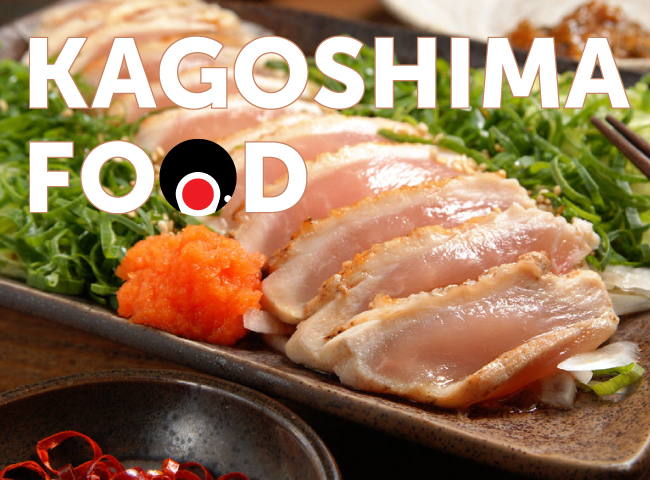9 Types of Tofu: Uncovering the True Taste of Japanese Tofu


So, what are your thoughts on tofu? If the thought of taking a bite gives you shivers, then you’ve likely never tasted the amazing tofu of Japan! Unlike the healthy “food-like substance” known as “tofu” in Western countries, Japanese tofu is a dish so flavorful that it deserves to sit on a culinary pedestal of Asian cuisine. Whether splashed with soy sauce, deep fried or sweetened, start your journey with the many unique textures and tastes of these 9 types of Japanese tofu.
9 Types of Tofu to Tickle Your Taste Buds
Before jumping off the tofu deep end, there is one thing that must be set straight: the difference between “tofu” and “dofu.” There is none—they are the same thing. As what happens often in the Japanese language, a word like “tofu” when combined with another word will slightly change how it’s pronounced; in this case, when asking for some types of tofu in Japan the “t” is dropped for a “d.” So, please don’t be confused, because there is no difference. Now on to the tofu!
Kinu-dofu (Kinugoshi)

Of all the tofu types out there, kinu-dofu or kinugoshi (“silken” tofu) really lives up to its name. This softly textured tofu is made by combining soy milk with nigari salt bitterns coagulant and gently heating the mixture until it sets into tofu. The result is a refreshing, lightly sweet and creamy tofu that is a lot like custard.
The delicate flavor of kinu-dofu is best enjoyed in dishes that require little or no cooking, so the natural flavor of the tofu can be appreciated. This includes Japanese dishes like miso soup, hiyayakko (chilled tofu seasoned with soy sauce and garnished with freshly grated ginger, bonito fish flakes, and scallions), and yu-dofu (gently simmered tofu dipped in soy sauce or ponzu citrus dressing). For Western cuisines, kinu-dofu makes a great vegan substitute or dairy alternative for the lactose intolerant. Try blending it into soups, dips, and smoothies, or even use it to make tofu ice cream. Kinu-dofu is also used in a number of Japanese desserts, such as tofu pudding and tofu shiratama dumplings.
Momen-dofu

Next is momen-dofu or “cotton” tofu, made from silken tofu that has been pressed to drain the liquid. This process gives momen-dofu a firmer and relatively rough texture that makes it a good choice for dishes that involve grilling, stir-frying, or simmering with vegetables. It can also be coated in flour or potato starch and deep-fried to make agedashi-dofu—piping hot, crispy tofu that’s silky in the center, served in a sweet and savory dashi broth. Yaki-dofu, a grilled variety of momen-dofu that keeps its shape well, can often be found in stores. It’s a popular ingredient for dishes like nabe (Japanese hot pot) and sukiyaki (beef simmered with vegetables and yaki-dofu in a sweet soy sauce broth, dipped in raw egg).
Goma-dofu

Black and white goma-dofu is different from other types of tofu in that it’s made from sesame seed paste rather than soybeans. It gets its origins in shojin ryori, the traditional Buddhist cuisine from Kyoto. Making goma-dofu is a labor-intensive process because it involves grinding sesame seeds into a fine powder, which was traditionally seen as a character-building exercise for novice monks. The results are worth it, though, as the rich aroma of sesame comes through in every bite. Enjoy chilled goma-dofu with a bit of soy sauce and a dab of freshly ground wasabi.
Atsuage & Aburaage

Similar to agedashi-dofu, atsuage is another deep-fried tofu dish but without the flour coating. To make atsuage, thickly sliced momen-dofu is deep-fried to give it a crispy golden exterior. It’s perfect for those who want something a bit firmer and heartier than regular momen-dofu or yaki-dofu. Atsuage can be eaten as is like a tofu steak or sliced and used as a topping for soups (miso, udon, ramen, etc.) and in salads.
Another similar tofu dish is aburaage, which is deep-fried until an air pocket forms inside the tofu and very little of the soft white tofu remains. Abura-age is used to make inarizushi, those delightfully sweet, fried tofu pouches that have sushi rice inside.
Koya-dofu (Shimi-dofu)

There are actually two freeze-dried kinds of tofu. Koya-dofu is freeze-dried tofu that originated from a famous Buddhist temple on Mt. Koya in Wakayama prefecture. It is typically rehydrated, then simmered in soup stock and served with a simple dressing, such as soy sauce and mirin (sweetened rice wine). Koya-dofu has a unique spongy texture that’s a hit with many people in Japan.
Shimi-dofu is a similar kind of tofu from the Nagano region, dating back to the late 1500s. It was made by hanging tofu out in the cold during winter, which naturally dried it. Nowadays, shimi-dofu is freeze-dried like koya-dofu and the names are interchangeable.
Iburi-dofu

Iburi-dofu is a very old regional delicacy from the Gifu area, where it’s been produced since the Kamakura period (1185–1333). Tofu from this area is made with three times the amount of soybeans as typical tofu. The tofu is cut into blocks and then smoked using sakura chips, which imparts a flavor very much like smoked cheese. If eaten straight, iburi-dofu is best paired with sake. Otherwise you can try topping it with soy sauce, wasabi, or even mayonnaise.
Okinawa Tofu (Shima-dofu)

Not to be confused with shimi-dofu, shima-dofu (spelled with an “a” instead of an “i”) is another name for Okinawa tofu. It’s one of the firmer tofu types that’s sold as a big 1 kilogram block without any water, compared to traditional Japanese tofu, which is sold as 300 gram blocks packaged in water. Shima-dofu is an essential ingredient for making goya champuru, a regional dish from Okinawa with stir-fried bitter melon, eggs, bacon or pork, and of course, tofu.
Yuba

Yuba or “tofu skin” is Kansai regional delicacy that comes from Kyoto. It’s a by-product of the tofu making process that forms on top of the soy milk as it’s being heated. Fresh yuba has a delicate flavor and a texture similar to mozzarella cheese. It can be served raw with a bit of ponzu dressing, or with wasabi and soy sauce like sashimi. Dried yuba is typically fried, boiled, or served in soup. Sheets of yuba can also be used like nori (seaweed) to wrap other ingredients.
Okara

Okara is another by-product of the tofu making process and equally delicious. It’s a fiber-rich filler that can be used to add bulk to other dishes. Okara is also a useful source of protein and an excellent alternative to meat, which most people will recognize as the main ingredient in food such as tofu burgers. In Japan, one of the most popular ways to eat okara is to sauté it with vegetables to make a salad called unohana. It can also be added to soups or even baked goods—okara donuts have become extremely popular within the past few years! Okara cookies, low in calories but high on hearty taste, are also on the rise.
9 Tofu Types to Suit Every Taste
From the delectably deep-fried to the nutritious but delicious, there are obviously many types of tofu to fit any mood. If you’ve been tempted by all this tofu talk, it’s time to come to Japan and explore the true world of tofu. Happy tofu tasting!








